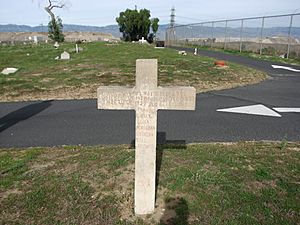Agua Mansa, California facts for kids
Quick facts for kids
Agua Mansa
|
|
|---|---|
| Country | United States of America |
| State | California |
| County | San Bernardino |
| Elevation | 922 ft (281 m) |
| Time zone | UTC-8 (Pacific (PST)) |
| • Summer (DST) | UTC-7 (PDT) |
| GNIS feature ID | 238451 |
| Agua Mansa Cemetery | |
|---|---|
 |
|
| Built | 1845 |
| Designated | May 15, 1933 |
| Reference no. | 121 |
Agua Mansa was a settlement in San Bernardino County, California. Its name means "gentle water" in Spanish. It was once the biggest town in the county. Today, it is a ghost town, meaning it's mostly abandoned. Only its historic cemetery remains.
The town started in 1842 in early California. It was located by the Santa Ana River. Across the river was another settlement called La Placita. Agua Mansa and La Placita were the first non-native towns in the San Bernardino Valley. Together, they were known as "San Salvador." In the 1840s, they were the largest settlements between Santa Fe de Nuevo México and Pueblo de Los Ángeles.
Contents
Exploring Agua Mansa's Location
The Agua Mansa Valley sits on the south side of Slover Mountain. This valley was about 6 miles (9.7 km) long. Its width changed, usually between 0.5 miles (0.8 km) and 0.75 miles (1.2 km). This depended on the river flowing through it.
The land was used for farming. It had many fields, owned by different ranchers. The lower part of the valley had a forest of Frémont's cottonwood trees. The upper part was a sandy plain.
The Story of Agua Mansa
How Agua Mansa Began
In 1845, a man named Don Juan Bandini gave some of his land to a group of settlers. These settlers were from New Mexico. They were led by Santiago Martinez and Manuel Lorenzo Trujillo. They received the land on one condition: they had to protect the area from local Indian raids.
Ten families moved to 2,000 acres (810 ha) on the east side of the Santa Ana River. They formed the village of La Placita. Another group settled on the west side of the river. This group formed the town of Agua Mansa. Leaders of this group included Santiago Martinez, Manuel Lorenzo Martinez, and Hipilito Garcia.
The San Salvador Church
In 1852, an adobe church in La Placita collapsed into quicksand. So, a new church was built in Agua Mansa. It was finished in 1853 and named San Salvador. This church survived the Great Flood of 1862.
The church parish served both Agua Mansa and La Placita. It became known as San Salvador de Jurupa. This was the first non-mission church in Southern California. The church's original bell now hangs at the Glenwood Mission Inn.
The Great Flood of 1862
Agua Mansa thrived for nearly 20 years. But in 1862, a huge flood changed everything. The flood washed away many of the town's adobe buildings. It left the area covered in sand and gravel.
The town was rebuilt on higher ground. However, it never regained its earlier success.
Jensen Alvarado Ranch
The Jensen Alvarado Ranch was built in Agua Mansa in 1870. It is now a California Historical Landmark. It is also listed on the National Register of Historic Places. This ranch had a vineyard that made and sold thousands of gallons of wine every year.
Agua Mansa Pioneer Cemetery
The Agua Mansa Pioneer Cemetery is a very important historical site. It is California Historical Landmark No. 121. This cemetery is the only part of the old town that still exists. The first person was buried here in 1852. The last burial happened 111 years later, in 1963.
The cemetery has a museum and a chapel. You can even take tours to learn more about its history.
We don't have all the records for who is buried here. But about 1,400 names have been found as of October 2018. Experts believe there are around 2,000 burials in total. Only a few grave markers remain today.
Some famous people buried here include:
- Louis Rubidoux: He came to California in 1844. He bought the Jurupa Rancho, near what is now the City of Riverside.
- Cornelius Jensen: A Danish sea captain. He opened a store in Agua Mansa. He was buried here in 1886.
- Mercedes Alvarado: Cornelius Jensen's wife. She is buried with other members of her family.
- Lorenzo Trujillo: One of the original leaders of the community. His grave marker is now lost.
- Isaac Slover: A mountain man and bear hunter. He was killed by a bear in 1854.
California Historical Landmark Marker
The official marker at the cemetery says: This historic site marks the resting place of the pioneers of the Agua Mansa area which was started about 1840. The preservation of this cemetery began in 1951. It was put up in 1961 by the Jurupa Palor No. 296 Native Daughters of the Golden West. (Marker Number 121.)
Agua Mansa in Books
Agua Mansa is the name of a made-up town in a book. The novel Still Water Saints by Alex Espinoza features a fictional Southern California town called Agua Mansa.
See also




